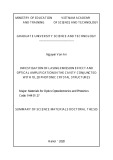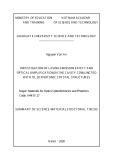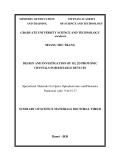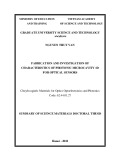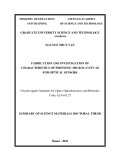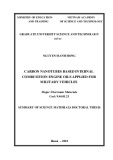MINISTRY OF EDUCATION
VIETNAM ACADEMY
AND TRAINING
OF SCIENCE AND TECHNOLOGY
GRADUATE UNIVERSITY SCIENCE AND TECHNOLOGY
NGUYEN MANH HONG
CARBON NANOTUBES BASED INTERNAL
COMBUSITION ENGINE OILS APPLIED FOR
MILITARY VEHICLES
Major: Electronic Materials Cod: 9.44.01.23
SUMMARY OF SCIENCE MATERIALS DOCTORAL THESIS
Hanoi – 2018
The thesis was completed at Key Laboratory for Electronic
Materials and Devices, Institute of Materials Science, Vietnam
Academy of Science and Technology.
Supervisors:
Prof. Dr. Phan Ngoc Minh
Reviewer 1:
Reviewer 2:
Reviewer 3:
The thesis is defended to the thesis committee for the Doctoral
Degree, at Graduate University of Science and Technology –
Vietnam Academy of Science and Technology,
on.....Date...Month...Year 2018.
Hardcopy of the thesis can be found at:
- Library of Graduate University of Science and Technology
- National Library of Vietnam
INTRODUCTION
1. Rationale for Study
Vehicles such as trucks, battle tanks, amoured vehicles, ships are
fundamental facilities in military. Those vehicle-engine durability,
lifespan, and horsepower are important factors and enhancement of
such parameters is necessary.
Previous research works have been shown that the presence of
carbon nanotubes (CNTs) in internal combustion engine oils
(lubricating and thermal transfer oils) gives rise to the reduced engine
friction and the increased heat sink. This contributes positively to
engine yield performance, durability, lifespan, and fuel savings as
well. The CNT-based engine oils have been manufactured in USA,
EU, Japan, and Korea and used mostly in military sectors. Therefore,
know-how finding and successful fabrication of the CNT-based
engine oils are necessary and meaningful in many facets. Given that
fact, author is focused on the field of research “Carbon nanotubes
based internal combustion engine oils applied for military vehicles”
for his PhD course.
2. Aims
- Fabrication of the carbon nanotube based internal combustion
engine oils from the Poly-alpha-olephin (PAO) oils;
- Building the heat transfer model of the internal combustion
engines using the CNTs-based oils, and characterization;
- Applications of the CNTs-based oils in military vehicles and
equipment.
3. Main points of thesis
- Fabrication of the carbon nanotube based internal combustion
engine oils;
1
- Measurement, characterization of CNTs-based oils regarding
their structures, physical, thermal, and electrical properties;
- Heat dissipation modeling and thermal-conductivity
computation of the carbon nanotube based internal
combustion engine oils, and comparison with the
experimental results;
- Field tests of the as-fabricated CNTs-based oils in some
military vehicles;
- Optimization of the CNTs-based oil parameters that includes
processing techniques, aiming to practical applications.
4. Thesis presentation
The thesis work includes 142 pages, consisting of Preface – 04
pages; Chapter 1: An overview of carbon nanotubes based fluids – 39
pages; Chapter 2: Experimental methods – 10 pages; Chapter 3:
Fabrication of CNTs-based engine oils: Experimental results – 31
pages; Chapter 4: Applications of the carbon nanotube based internal
combustion engine oils in military vehicles- 41 pages; Conclusion:
02 pages; Publications - 03 pages; References - 11 pages.
5. Main findings and contributions of the thesis
- Know-how finding and successful fabrication of the carbon
nanotube based internal combustion engine oils from the Poly-alpha-
olephin (PAO) oil and well-applied for military vehicles.
- Four types of the carbon nanotube based internal combustion
engine oils have been manufactured and successfully tested for small
ships, battle tanks, amoured vehicles, and military trucks.
- The carbon nanotube based internal combustion engine oils
(military vehicles) have been tested, the test results confirmed
2
engines‟ high performance in general, fuel saving of 10-15% and the
oil change intervals reduced 04 (four) times, in particular.
Chapter 1: Overview of carbon-nanotube-based fluids
1.1 Introduction
1.1.1. Introduction to carbon nanotubes
Carbon nanotubes are nanoscale materials which have been
researched with promising application potentials. They consist of two
main forms: carbon nanotubes (CNTs) and carbon nanofiber (CNF).
In 1991, Sumio IiJma, scientist at Japanese company – NEC,
discovered tiny hollow-tubular crystals with the diameter of
approximately 1.4 nm and the length of few microns to even
millimeters. He soon published his discovery on Nature and the term
“carbon nanotubes” was born.
1.1.2. CNT structure
The nature of carbonous linkage inside CNTs matrix is explained
by the orbital overlaps. It is formed completely by sp2 hybridization
(comparably to graphite), which is stronger than sp3 bond in
diamond. As a result, CNTs have very high strength with strong Van
der Waals interaction in their rope-like network.
There are two types of CNTs: single-walled carbon nanotubes
(SWCNTs) and multi-walled carbon nanotubes (MWCNTs).
1.1.3. Methods of CNTs synthesis
There are plenty of ways to synthesize CNTs materials, most
commonly laser ablation and chemical vapor deposition (CVD).
1.1.4. CNT properties
1.1.4.1. Mechanical properties
3
CNTs inherit high strength, high elasticity and high hardness in
comparison to other materials.
1.1.4.2. Optic and Optoelectronic properties
Based on the different non-monotonic structures of CNTs,
especially SWCNTs, they possibly have the specific band gap.
Because of these metallic and semiconductor behaviors, CNTs can be
applied in optic and optoelectronic fields.
1.1.4.3. Thermal properties
CNTs have very high thermal conductivity along their axis. Many
works have been focus on thermal properties of carbon nanotubes in
order to find application in opto-electronic devices, LED,
microprocessor heat transfer…
1.2. Carbon nanotube based thermal dissipation fluids
1.2.1. Introduction to heat transfer nanofluid
Nanofluilds are made of nanomaterials dispersed in aqueous
solution, e.g, water, ethylene glycol, oil. In other words, nanofluids
are mixture of two-phase compounds, nanomaterials and solvents.
1.2.2. Fabrication methods
There are two main approaches to fabricate nanofluids, the two-
step process and the one-step process.
1.2.3. CNTs-based fluid
1.2.3.1. Fabrication of the CNTs-based fluid
To achieve the CNTs-based fluids, the most important point is to
well disperse carbon nanotubes into oil solvents. To avoid nanotube
aggregation, CNTs have to be functionalized in advance.
1.2.3.2. Thermal properties of CNTs based nanofluids
4
Carbon nanotubes have excellent thermal conductivity, three
orders better than those of other fluid materials. Therefore it is used
in thermal management applications.
1.2.3.3. Heat transfer model of carbon nanotube based fluids
To explain the heat transfer of the CNTs based fluids, many
research groups have introduced theoretical models. In particular,
In Hemanth‟s model, thermal conductivity of the CNTs-based
fluid has been formulated as follow
In H E Patel„s model
However, we can see that there is inaccuracy in H E Patel‟s
model, there is difference in experimental value and modeling
calculation.
1.2.4. Nanofluid applications
Nanofluids can be used in thermal applications. For example, heat
transfer, thermal dissipation, thermal interface management in
engines, electronics.
1.3. Heat dissipation lubricant oils
1.3.1. Introduction
Lubricant oils include two compounds, base oil and additives.
Lubricant oils can be applied in engine (tribological decrease, metal-
oxidation proof, self-cleaning, heat sink…).
1.3.2. Lubricant oil specifications
There are two specifications of typical lubricant oils including
SAE and API:
5
- SAE index: Classify the lubricant oils following temperature
(American Society of Mechanical Engineers – ASME).
- API index: Determine oil quality, established by American
Petroleum Institute – API.
1.3.3. Additives in lubricant oils
Additives in lubricant oils are organics and/or inorganic
compounds that is added in the based oil in order to increase oil
performance. In practice, the additives are widely used in engine oils
which help increase oil viscosity, oxidation proof, detergent ability,
and reduce tribological coefficient.
1.3.4. Fabrication of lubricant oil using carbon nanotubes as
additives
Lubricant oils have been used widely in many industries. Much
research have been carried out to optimize and enhance the oil
performance. However, fabrication of the engine oil in general is an
uneasy process. There few tens compounds in the commercial engine
oils. Ones have to find the proper mixture ratio of those compounds
that require tremendous experiments and tests.
1.3.5. Heat transfer CNTs-based oils
In heat dissipation lubricant oils , carbon nanotubes disperse in
petroleum with a small size when exposed to a metal surface that
forms a protective film for the components. As the temperature and
pressure in the engine increase, the nano carbon particles form a
tough protective film, which makes the lubrication even more
effective, no abrasion, maximum friction reduction.
Lubricants use high-pressure carbon nanotubes to seal the
combustion chamber in the engine, thus minimizing the leakage of
fuel and impurities generated during fuel combustion. The engine is
6
always clean, fuel-efficient and resistant to the formation of deposits
at the bottom of the engine caste.
1.4. CNTs-based nanofluid research in Vietnam and Oversea
1.4.1. CNTs-based nanofluid research Oversea
There are many research works regarding lubricant oils based on
carbon nanotubes. Scientists over the world try to disperse carbon
nanotubes into the base oil to increase thermal transfer, tribological
coefficient, engine lifespan… CNTs-based oils can be used in engine
industry, thermal management. Some oil companies have introduced
nanomaterial filled oils into the markets.
1.4.2. CNTs-based nanofluid research in Vietnam
As far as the thesis author understands, there is no laboratory or
oil companies in Vietnam can manage to manufacture lubricant oils
for automobile engine adding carbon nanotubes. Most research is to
disperse nanomaterials in base oil and measure their thermal
properties.
Therefore, the thesis author believes that fabrication of the CNTs-
based engine oils is new in Vietnam. This research can open the way
to fabricate lubricant oils and apply in military vehicles (truck,
tanks,…).
Chapter 2: Research Methods
2.1. Practical Methods
2.1.1. Method of functionalizing CNTs
By using strong oxidants, functionalized groups, mostly hydroxyl
(-OH) and carbonyl (-COOH) will “attach” or bond to CNT surface.
2.1.2. Dispersion method of additives in base oil
Each engine has its own requirements to function efficiently so
the specification of lubricant for them is depended.
7
2.1.3. Measurement and characterization
To measure and characterize the properties of CNTs and nano-
lubricant oil, author and coworker have done various techniques such
as Scanning Electron Microscopy, Raman Spectroscopy, Fourier
Transform Infrared Spectroscopy and Zeta-sizer.
2.1.4. Measurement of nano-lubricant oil specifications
To investigate the specification of nano-lubricant oil, we have
used some lab-instruments, namely Kinematic Viscometer 9410p
(Belgium), Total Alkalinity Meter, Tensiometer, Total Metal
Analyzer, Petroleum Pour Point, Electrical conductivity meter.
2.2. Simulation modeling and theoretical calculation
From the theoretical works of many research groups worldwide, a
novel model will be built with less drawbacks and higher accuracy
than the previous ones.
2.3. Precursor materials
2.3.1. Precursors for lubricant oil
Anti-abrasion additives (triphenylphosphorothionate), anti-
corrosion additives (alkylated succinic acid), less-friction
functionalized additives (molybdenum disulfide), foam-control
additives (Ethylene Bis-Stearamide), anti-oxidants (zinc dialkyl
dithiophosphates),…
2.3.2. Precursors for heat dissipation
- Carbon nanotubes
- Poly α-olefin oil (US)
- Tween-80 surfactant (Sigma-Aldrich)
- CNT functionalizing chemicals: HNO3 (Merck), H2SO4 (Merck),
SOCl2 (Sigma
Aldrich), H2O2 (Merck),...
8
- Other solvents: DI water, ethanol, acetone,…
2.4. Research instrument
2.4.1. CNTs-lubricant-dispersing Instrument
Ultrasonication Machine Microson XL2000, Ultrasonic bath Elma
S40H, Stirrer, …
2.4.2. Other instruments for synthesizing nano-carbon based
lubricant
Vacuum filtration machine, Micro Balance, Fume Hood, Vacuum
Oven,…
Chapter 3: Fabrication of CNTs-based engine oils:
Experimental results
3.1. Functionalization of carbon nanotubes
Figure 3.2: FTIR spectra of carbon nanotubes before and after
functionalization regarding –COOH and –OH groups.
The FTIR spectra of CNTs - COOH show peaks in corresponding
to carbon nanotubes functionalized by H2SO4 and và HNO3 mixture,
9
it confirmed appearance of functionalized group on the carbon
nanotube walls.
Figure 3.3: Raman spectroscopy of carbon nanotubes before and after functionalization regarding –COOH and –OH groups.
There occur two typical D (1333,69 cm-1) and G 1583,10 cm-1) bands, ID /IG intensity ratios are 0,99 and 1,87 in response to CNTs - COOH and CNTs - OH, respectively. Both ID /IG intensity ratio of the functionalized CNTs are greater than that of the pristine CNTs
(0,79). It can be assumed that the CNT structure has been changed
due to functionalization.
3.2. Fabrication of the heat dissipation CNTs-based engine oil
3.2.1. Carbon nanotube dispersion in base oil (PAO)
10
Figure 3.5: Dispersion process of carbon nanotubes in PAO oil
3.2.2. Optimization of carbon nanotube weight ratio in engine oil
- The ultra-sonication parameters for 60 minutes
- CNTs %wt: 0,12
3.2.3. Carbon nanotube dispersion
Carbon nanotubes are dispersed into the base oil following processes:
- Chemical functionalization
- Surface surfactant addition
- Experimental process: ultra-sonication
3.2.4. Optimization of the additives: weight ratio and types
3.3. Heat transfer model and thermal conductivity of the CNTs-
based oils
3.3.1. Heat transfer model
3.3.2. Heat transfer model: analysis and comparison
11
The heat transfer model in the thesis has been compared with
other research works, for example, Hwang‟s (2006), Lifei Chen‟s
(2008), Gensheng Wu‟s (2009). The analysis shows that the
theoretical calculation in the thesis is good agreement with previous
study, in particular, CNTs dispersion in H2O, ethylene glycol, R113
fluids.
Figure 3.15. Thermal conductivity of the CNTs-based engine oils with different CNTs weights: Experimental results and theoretical calculation
The results show that the highest thermal conductivity is 0,292
W/mK (theory) and 0,298 W/m (experiment) in corresponding to the
CNTs dispersion of 0,12% in weight.
3.4. Characterization of the CNTs-based engine oil during field
tests
3.4.1. Viscosity coefficient
12
In general, the as-prepared oil‟s viscosity increases following the
CNTs weight in the oils. However, with CNTs 0,03 % in volume, the viscosity at 100oC and 40oC tends to reduce slightly. The observed result is consistent with the previous research carried out by Ehsan-o-
llah Ettefaghi.
3.4.2. Specifications of the as-fabricated CNTs-based engine oils
The properties of the nano heat dissipation lubricant oils include
dynamic viscosity, viscosity index, total alkalinity, ignition point,
total metal content, surface tension, freezing point measured by us.
The results show that the heat dissipation produced to meet the
technical standards set out.
Determining the specifications of the lubrication oil for each
engine type shows that when adding CNTs, the lubricating oil heat
dissipation reduces friction, fuel savings and increased thermal
conductivity. Requires not to break the oil structure and still meet the
world standards.
Chapter 4 – Applications of the carbon nanotube based internal
combustion engine oils in military vehicles
4.1. Field tests of the CNTs-based engine oils in small ships
4.1.1. Engine oil temperature
The oil‟s saturation point is 50,6 oC (after 20 minutes in operation). The commercial engine oil, temperature of about 49,8oC while as for the CNTs-based engine oils, temperature of about 46,1oC. 4.1.2. Engine tribology coefficient
Using the CNTs-based engine oils help reduce the engine
tribology coefficient and order of 1,22 in comparison with the one of
the commercial engine oil.
13
4.1.3. Fuel consumption
Using the CNTs-based engine oils help save the fuel consumption
of 10,88%.
4.1.4. Characterization of the CNTs-based engine oil during field
tests
The field test results show that the CNTs-based oil is still good in
quality after 250 hours in use (constant engine running), the oil
sample has been accordance with ГОСТ 12.337-84 (Russia).
4.2. Field tests of the CNTs-based engine oils in military tanks
4.2.1. Engine oil temperature
The oil‟s saturation point is 54,6oC (after 20 minutes in operation). The commercial engine oil, temperature of about 53,8oC after 20 minutes in operation while as for the CNTs-based engine oils, temperature of about 45,0oC. 4.2.2. Engine tribology coefficient
Using the CNTs-based engine oils help reduce the engine
tribology coefficient and order of 1,21 in comparison with the one of
the commercial engine oil.
4.2.3. Fuel consumption
Using the CNTs-based engine oils help save the fuel consumption
of 10,39%.
4.2.4. Characterization of the CNTs-based engine oil during field
tests
The field test results show that the CNTs-based oil is still good in
quality after 250 hours in use (constant engine running), the oil
sample has been accordance with ГОСТ 6360-83 (Russia).
4.3. Field tests of the CNTs-based engine oils in amoured vehicles
4.3.1. Engine oil temperature
14
The oil‟s saturation point is 44,6oC after 20 minutes in operation. The commercial engine oil, temperature of about 43,7oC while as for the CNTs-based engine oils, temperature of about 40,4oC. 4.3.2. Engine tribology coefficient
Using the CNTs-based engine oils help reduce the engine
tribology coefficient and order of 1,24 in comparison with the one of
the commercial engine oil.
4.3.3. Fuel consumption
Using the CNTs-based engine oils help save the fuel consumption
of 11,21%.
4.3.4. Characterization of the CNTs-based engine oil during field
tests
The field test results show that the CNTs-based oil is still good in
quality after 250 hours in use (constant engine running), the oil
sample has been accordance with ГОСТ 6360-85 (Russia).
4.4. Field test of the CNTs-based oils in military transport
vehicles
4.4.1. Engine oil temperature
The oil‟s saturation point is 45,4oC. The commercial engine oil, temperature of about 44,2oC after 20 minutes in operation while as for the CNTs-based engine oils, temperature of about 41,2oC. 4.4.2. Engine tribology coefficient
Using the CNTs-based engine oils help reduce the engine
tribology coefficient and order of 1,29 in comparison with the one of
the commercial engine oil.
4.4.3. Fuel consumption
Using the CNTs-based engine oils help save the fuel consumption
of 15,79%.
15
4.4.4. Characterization of the CNTs-based engine oil during field
tests
The field test results show that the CNTs-based oil is still good in
quality after 250 hours in use (constant engine running), the oil
sample has been accordance with ГОСТ 17479.1-85 (Russia).
4.5. Field test of the CNTs-based engine oils
4.5.1. Testing on the amoured vehicles
The commercial engine oils: 60,9 litter/ 100 km (average speed of
52,8 km/h)
The CNTs-based engine oils: 54,8 litter/ 100 km (average speed of
52,8 km/h)
It means that using the CNTs-based oil can save 10,2 % fuel
consumed.
4.5.2. Field test of the CNTs-based engine oil in military truck
The commercial engine oils: 49,1 litter/ 100 km (average speed of
63,1 km/h)
The CNTs-based engine oils: 41,5 litter/ 100 km (average speed of
63,1 km/h)
It means that using the CNTs-based oil can save 15,3% fuel
consumed.
4.6. Heat dissipation testing of the CNTs-based oils on high-
power LED system
16
Figure 4.34: Temperature graph of the LED 300W headlamp and the
LED heat dissipation system (with and without using the CNTs-
based oils as thermal agents)
Heat dissipation mechanism: Thermal transfer of the as-fabricated
oils is increased by introduction of carbon nanotubes which have
high thermal conductivity. Using the CNTs-based heat-transfer oils
help to reduce the LED-chip‟s temperature a magnitude of 8ºC.
17
CONCLUSION
- The successfully functionalized CNTs using chemical methods and
then the fabricating process of the heat-dissipation CNTs-based oils.
- Finding the optimized ratios and weights of the additives in order to
fabricate, characterize the as-prepared heat-dissipation CNTs-based
oils.
- Building the thermal transfer and the theoretical calculation of the
as-prepared oils‟ thermal conductivity. The highest thermal
conductivity of the CNTs-based oils, 0,292 W/mK is obtained with
0,12% CNTs in weight percentage.
- Field tests of the CNTs-based oils in vehicle engines (small ship,
V2 tank, BTR-60 PB, ZIL 131…). The CNTs-based engine oils assist
increase the engine lifespan, fuel saving, reduce the engine‟s CO2 emission…. The test results also confirmed the as-prepared engine
oils in accordance with Russian oil specifications and standards.
PUBLICATIONS AND PRESENTATIONS
1. Journal papers
1.1. ISI-indexed journal publication
1. Nguyen Manh Hong, Bui Hung Thang, Phan Ngoc Hong,
Nguyen Tuan Hong, Phan Hong Khoi, and Phan Ngoc Minh,
“Carbon Nanotubes based Lubricating Oils for UAZ 31512 Engines”,
Micro & Nano Letters, 4 pp. DOI: 10.1049/mnl.2016.0280, Online
ISSN 1750-0443, (2016).
2. Manh Hong Nguyen, Hung Thang Bui, Van Trinh Pham,
Ngoc Hong Phan, Tuan Hong Nguyen, Van Chuc Nguyen, Dinh
Quang Le, Hong Khoi Phan and Ngoc Minh Phan, “Thermo-
mechanical properties of Carbon nanotubes and applications in
18
thermal management”, Advances in Natural Sciences: Nanoscience
and Nanotechnology, vol 7, issue 3 (2016).
3. Dang Van Thanh, Nguyen Van Thien, Bui Hung Thang,
Nguyen Van Chuc, Nguyen Manh Hong, Bui Thi Trang, Tran Dai
Lam , Dang Thi Thu Huyen, Phan Ngoc Hong , Phan Ngoc Minh, “A
Highly Efficient and Facile Approach for Fabricating Graphite
Nanoplatelets”, Journal of Electronic Materials 45, 5, 2522-2528
(2016).
1.2. International journal publication (Others)
4. Ngoc Minh Phan, Hung Thang Bui, Manh Hong Nguyen and
Hong Khoi Phan, “Carbon-nanotube-based liquids: a new class of
nanomaterials and their applications”, Advances in Natural Sciences:
Nanoscience and Nanotechnology, vol 5, 015014 (5pp) (2014).
5. Bui Hung Thang, Le Dinh Quang, Nguyen Manh Hong,
Phan Hong Khoi, and Phan Ngoc Minh, "Application of Multiwalled
Carbon Nanotube Nanofluid for 450 W LED Floodlight", Hindawi
Publishing Corporation Journal of Nanomaterials Volume 2014,
Article ID 347909, (6 pp).
6. Nguyen Manh Hong, Bui Hung Thang and Phan Ngoc Minh,
"Calculation the Thermal Conductivity of Nanofluids Containing
Aligned Ultralong Single Walled Carbon Nanotubes", Physical
Science International Journal 10(1): 1-8, 2016, Article no.PSIJ.24520
ISSN: 2348-0130.
7. Pham Van Trinh, Nguyen Ngoc Anh, Bui Hung Thang, Le
Dinh Quang, Nguyen Tuan Hong, Nguyen Manh Hong, Phan Hong
Khoi, Phan Ngoc Minh and Phan Ngoc Hong, "Enhanced thermal
conductivity of nanofl uid-based ethylene glycol containing Cu
19
nanoparticles decorated on a Gr– MWCNT hybrid material", RSC
Adv., 2017, 7, 318.
1.3. National journal publications
8. Nguyễn Mạnh Hồng, Bùi Hùng Thắng, Phan Hồng Khôi,
Phan Ngọc Minh, “Nghiên cứu dầu bôi trơn tản nhiệt chứa thành
phần ống nano-cacbon cho động cơ đốt trong”, Tạp chí Khoa học Đại
học Huế Vol 121, No 7-A (2016).
1.4. Proceeding publications
9. Nguyen Manh Hong, Bui Hung Thang, Phan Ngoc Hong,
Nguyen Tuan Hong, Phan Hong Khoi, Phan Ngoc Minh “Carbon
Nanotubes based Lubricating Oils for Engines”, The 11th Annual
IEEE International Conference on Nano/Micro Engineered and
Molecular Systems (IEEE-NEMS 2016), Matsushima Bay and
Sendai MEMS City, Japan, 17-20 April, 2016 (invited speaker).
10. Nguyen Manh Hong, Bui Hung Thang, Phan Hong Khoi, and
Phan Ngoc Minh “Lubricating oils containing multi-walled carbon
nanotubes for engine”, The 5th International Workshop on
Nanotechnology and Application (IWNA 2015), 630-633
11. Nguyen Manh Hong, Bui Hung Thang, Phan Ngoc Hong, Le
Dinh Quang, Phan Hong Khoi and Phan Ngoc Minh, “Heat
Dissipated Structure for High Brightness LightEmitting Diodes using
Carbon Nanotubes based Oil”, The 7th International Workshop on
Advanced Materials Science and Nanotechnology (IWAMSN2014) -
November 2-6, 2014 - Ha Long City, Vietnam
12. Bùi Hùng Thắng, Nguyễn Mạnh Hồng, Phan Hồng Khôi,
Phan Ngọc Minh, “Nghiên cứu ứng dụng vật liệu nano cácbon trong
dầu bôi trơn tản nhiệt”, Hội nghị VLCR 2015, 347-350
20
13. Phạm Văn Trình, Phan Ngọc Hồng, Nguyễn Mạnh Hồng, Lê
Đình Quang, Cao Thị Thanh, Nguyễn Văn Chúc, Bùi Hùng Thắng,
Phan Hồng Khôi và Phan Ngọc Minh, “Ứng dụng chất lỏng chứa
thành phần ống nano-cacbon đa tường trong tản nhiệt cho đèn Led
công suất lớn”, Tạp chí khoa học và công nghệ Việt Nam, Tập 2, 6,
(2015).
2. Patents and Intellectual property (IP)
– Patent: "Quy trình chế tạo dầu bôi trơn tản nhiệt chứa ống
nano-cacbon"; Chủ đơn: Trung tâm Phát triển công nghệ cao; Tác
giả: Phan Ngọc Minh, Nguyễn Mạnh Hồng, Bùi Hùng Thắng, Phan
Hồng Khôi; Cục Sở hữu trí tuệ chấp nhận đơn theo quyết định số
2563/QĐ-SHTT ngày 18/01/2016.
– Patent: “Bộ tản nhiệt công suất cao cho đèn LED chiếu sáng
công suất lớn” Chủ đơn Phạm Văn Hội, Nguyễn Mạnh Hồng; Cục Sở
hữu trí tuệ công báo sở hữu công nghiệp số A (05-2018). 25/05/2018.
21

